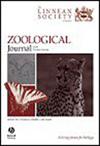Hybridogenetic reproduction of Pelophylax water frogs from different hemiclonal population systems from Eastern Ukraine: selective mortality, and clonal and ploidy diversity
IF 2.8
2区 生物学
Q1 ZOOLOGY
引用次数: 0
Abstract
European water frogs from the Pelophylax esculentus complex include two sexual species, Pelophylax ridibundus (genome RR) and Pelophylax lessonae (genome LL), and their hybrids (genome LR), which usually clonally transmit one of the parental species’ genomes. This reproductive strategy, known as hybridogenesis, allows hybrids to reproduce with parental species, creating diverse population systems. Unlike most well-studied populations in Europe, in the Siverskyi Donets River basin (eastern Ukraine), P. lessonae is absent, while diploid and polyploid hybrids coexist with P. ridibundus (R-E system). To reveal diverse system compositions, genetic divergence, and tadpole selective mortality, we combined novel data from over a decade of observations with previous research on population systems in the Siverskyi Donets River. Two key population types of the R-E system were identified: those with diploid hybrids in northern localities and those with both diploid and triploid hybrids, extending from the mainstream of the Siverskyi Donets River to its tributaries. Both sexes were found among both P. ridibundus and hybrids. Additionally, we found higher genetic diversity in R-genomes compared to L-genomes and discuss the cause of variation differences between the genomes. We highlighted the importance of continuous monitoring to unravel water frog population dynamics and complexity.乌克兰东部不同半克隆种群系统水蛙的杂交生殖:选择性死亡率、克隆性和倍性多样性
Pelophylax esculentus复合体中的欧洲水蛙包括两个有性种Pelophylax ridibundus(基因组RR)和Pelophylax lessonae(基因组LL),以及它们的杂交种(基因组LR),通常克隆传递亲本种中的一个基因组。这种繁殖策略被称为杂交种发生,允许杂交种与亲本物种繁殖,创造不同的种群系统。与欧洲大多数得到充分研究的种群不同,在乌克兰东部的Siverskyi Donets河流域,P. lessonae不存在,而二倍体和多倍体杂交种与P. ridibundus (R-E系统)共存。为了揭示不同的系统组成、遗传分化和蝌蚪选择性死亡率,我们将十多年来观察到的新数据与先前对Siverskyi Donets河种群系统的研究相结合。从西弗斯基-顿涅茨河的干流到支流,鉴定出两种关键种群类型:北部地区的二倍体杂交种群和二倍体和三倍体杂交种群。两种性别均存在于黄顶花和杂交种中。此外,我们发现r -基因组的遗传多样性高于l -基因组,并讨论了基因组之间变异差异的原因。我们强调了持续监测对揭示水蛙种群动态和复杂性的重要性。
本文章由计算机程序翻译,如有差异,请以英文原文为准。
求助全文
约1分钟内获得全文
求助全文
来源期刊
CiteScore
6.50
自引率
10.70%
发文量
116
审稿时长
6-12 weeks
期刊介绍:
The Zoological Journal of the Linnean Society publishes papers on systematic and evolutionary zoology and comparative, functional and other studies where relevant to these areas. Studies of extinct as well as living animals are included. Reviews are also published; these may be invited by the Editorial Board, but uninvited reviews may also be considered. The Zoological Journal also has a wide circulation amongst zoologists and although narrowly specialized papers are not excluded, potential authors should bear that readership in mind.

 求助内容:
求助内容: 应助结果提醒方式:
应助结果提醒方式:


